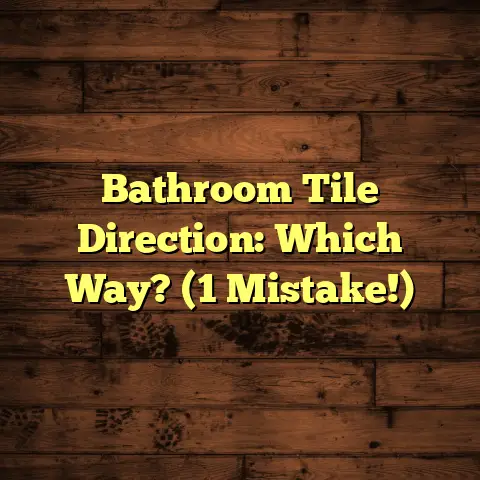Basement Floor Cost? (2 Day Install Price!)
I’m going to dive deep into the costs of basement flooring, focusing on options you can realistically get installed in just two days. Yes, you heard that right – a beautiful, functional basement floor in a weekend!
We’ll break down the different flooring types, the expenses involved, and what to expect during the installation process. Ready to transform your basement without sacrificing your precious time? Let’s get started!
1. The Importance of Choosing the Right Basement Flooring
1.1 Understanding the Unique Challenges of Basement Flooring
Basements are… well, basements. They’re often damp, sometimes musty, and generally not the most inviting spaces. Unlike your living room or bedroom, basements present some unique challenges when it comes to flooring.
Moisture is the big one. Basements are typically below ground level, making them susceptible to water seepage and humidity. This can lead to mold growth, warped floors, and a whole host of other problems if you don’t choose the right materials.
Temperature fluctuations are another factor. Basements tend to be cooler than the rest of the house, and they can experience significant temperature swings throughout the year. This can cause some flooring materials to expand and contract, leading to cracks or gaps.
Think of it this way: Your basement floor is like a shield against the earth. It needs to be tough, resilient, and able to withstand whatever Mother Nature throws its way.
1.2 The Impact of Moisture and Humidity on Flooring Options
Moisture is the arch-nemesis of many flooring materials. Wood, for example, is highly susceptible to water damage. It can warp, rot, and become a breeding ground for mold and mildew if exposed to excessive moisture.
Carpet, while cozy, can also trap moisture, leading to unpleasant odors and potential health hazards. Even some types of tile can be problematic if they’re not properly sealed.
So, what’s the solution? Choosing flooring materials that are specifically designed to withstand moisture and humidity. This might include vinyl, tile, or engineered hardwood with a moisture-resistant core.
I’ve seen firsthand the devastation that moisture can wreak on a basement floor. Trust me, it’s worth investing in a moisture-resistant option upfront to avoid costly repairs down the road.
1.3 How the Right Flooring Enhances Functionality and Aesthetics
Beyond just preventing water damage, the right basement flooring can completely transform the look and feel of your space. A well-chosen floor can make your basement feel warmer, more inviting, and more functional.
Think about how you plan to use your basement. Is it a playroom for the kids? A home theater? A home gym? The flooring you choose should be appropriate for the intended use.
For example, if you’re creating a playroom, you might want a soft, durable flooring option like carpet tiles or vinyl. If you’re building a home gym, you’ll need a floor that can withstand heavy weights and impact.
And let’s not forget about aesthetics! Your basement flooring should complement the overall style of your home. Whether you prefer a modern, minimalist look or a cozy, rustic vibe, there’s a flooring option out there that will suit your taste.
2. Common Flooring Options for Basements
Okay, now that we’ve covered the importance of choosing the right basement flooring, let’s dive into some of the most popular options. I’ll give you the lowdown on each one, including cost, installation time, and suitability for basement environments.
2.1 Vinyl Flooring
Vinyl flooring is a fantastic option for basements, and here’s why:
-
Cost Analysis: Vinyl is generally one of the most affordable flooring options. You can find basic vinyl rolls for as little as \$1 per square foot, while luxury vinyl planks (LVP) can range from \$2 to \$5 per square foot.
-
Installation Time: One of the biggest advantages of vinyl is its ease of installation. Many vinyl products are designed for DIY installation, and even if you hire a professional, it can typically be completed in a day or two.
-
Benefits: Vinyl is highly water-resistant, making it perfect for basements. It’s also durable, easy to clean, and comes in a wide variety of styles and colors.
-
Aesthetic Options and Durability Against Moisture: Vinyl flooring has come a long way in recent years. You can now find vinyl planks that mimic the look of hardwood or tile, without the risk of water damage. LVP, in particular, is incredibly durable and can withstand heavy foot traffic.
I’ve installed vinyl flooring in countless basements, and I’m always impressed by its versatility and performance. It’s a great option for homeowners who want a budget-friendly, low-maintenance flooring solution.
2.2 Laminate Flooring
Laminate flooring is another popular choice for basements, but it’s important to choose the right type:
-
Pricing Breakdown and Installation Specifics: Laminate flooring typically ranges from \$1 to \$5 per square foot. Installation is relatively straightforward, with many products featuring a click-lock system that makes it easy to install yourself.
-
Suitability for Basement Environments: While laminate is more affordable than hardwood, it’s not as water-resistant as vinyl. Look for laminate flooring that is specifically designed for basements and has a moisture-resistant core.
- Pro Tip: Always use a vapor barrier underlayment to protect the laminate from moisture seeping up from the concrete slab.
I’ve seen laminate flooring work well in basements, but it’s crucial to take precautions to prevent water damage. Make sure to address any existing moisture issues before installing laminate, and consider investing in a higher-quality, water-resistant product.
2.3 Tile Flooring
Tile flooring is a classic choice for basements, offering durability and timeless appeal:
-
Types of Tiles (Ceramic, Porcelain): Ceramic and porcelain tiles are both excellent options for basements. Porcelain is denser and more water-resistant than ceramic, making it a better choice for areas that are prone to moisture.
-
Cost Implications and Installation Considerations: Tile flooring can range from \$2 to \$10 per square foot, depending on the type and quality. Installation can be more labor-intensive than vinyl or laminate, and it’s generally best to hire a professional.
- Important: Make sure your subfloor is level and stable before installing tile. Any cracks or imperfections in the subfloor can cause the tile to crack over time.
Tile is a great option for basements because it’s waterproof, durable, and easy to clean. It’s also a good choice for high-traffic areas and spaces that are prone to spills.
2.4 Carpet
Carpet can make a basement feel warm and inviting, but it’s not always the best choice:
-
Pros and Cons of Using Carpet in Basements: Carpet is soft, comfortable, and can help to insulate a basement. However, it’s also highly susceptible to moisture damage.
- Cons: Carpet can trap moisture, leading to mold and mildew growth. It’s also difficult to clean and can stain easily.
-
Cost of Different Carpet Types and Installation: Carpet prices vary widely, depending on the type and quality. You can find basic carpet for as little as \$1 per square foot, while high-end options can cost \$5 or more per square foot. Installation costs can range from \$1 to \$3 per square foot.
If you’re set on having carpet in your basement, consider using carpet tiles. Carpet tiles are easier to replace if they get damaged, and they can be installed with a moisture-resistant adhesive.
I generally advise against using carpet in basements, unless you’re willing to take extra precautions to prevent moisture damage.
2.5 Engineered Hardwood
Engineered hardwood offers the look of real wood with improved moisture resistance:
-
Pricing and Installation Time: Engineered hardwood typically ranges from \$3 to \$10 per square foot. Installation is similar to laminate flooring, with many products featuring a click-lock system.
-
Advantages Over Traditional Hardwood in Basements: Engineered hardwood is made with a plywood or fiberboard core that is more resistant to moisture than solid hardwood. It’s also less likely to warp or expand and contract with temperature changes.
While engineered hardwood is more moisture-resistant than solid hardwood, it’s still not completely waterproof. It’s important to choose a product that is specifically designed for basements and to take precautions to prevent water damage.
3. Cost Breakdown of Basement Flooring Installation
Alright, let’s get down to the nitty-gritty: the cost of basement flooring installation. I’m going to break down the various expenses involved, so you can get a clear picture of what to expect.
3.1 Initial Material Costs
The cost of your flooring materials will depend on the type of flooring you choose and the size of your basement. Here’s a general idea of the price ranges for each option:
| Flooring Type | Price per Square Foot |
|---|---|
| Vinyl | \$1 – \$5 |
| Laminate | \$1 – \$5 |
| Tile | \$2 – \$10 |
| Carpet | \$1 – \$5+ |
| Engineered Hardwood | \$3 – \$10 |
Keep in mind that these are just estimates. The actual cost of your materials may vary depending on the brand, quality, and where you purchase them.
Factors influencing material choice includes:
- Budget: How much are you willing to spend on your basement flooring project?
- Moisture Resistance: How prone is your basement to moisture?
- Durability: How much foot traffic will your basement floor be subjected to?
- Aesthetics: What look and feel are you trying to achieve in your basement?
3.2 Labor Costs
If you’re not comfortable installing your basement flooring yourself, you’ll need to factor in labor costs. The average hourly rate for flooring installation varies depending on your location and the experience of the installer.
In my experience, you can expect to pay anywhere from \$30 to \$70 per hour for flooring installation. For a two-day project, the total labor cost could range from \$480 to \$1120, assuming an 8-hour workday.
Of course, this is just an estimate. The actual labor cost will depend on the complexity of the installation and the size of your basement.
3.3 Additional Expenses
In addition to the cost of materials and labor, there are a few other expenses to consider:
-
Underlayment: Underlayment is a layer of material that is installed under the flooring to provide cushioning, sound insulation, and moisture protection. The cost of underlayment can range from \$0.50 to \$2 per square foot.
-
Adhesives: If you’re installing vinyl or tile flooring, you’ll need to purchase adhesive to secure the flooring to the subfloor. The cost of adhesive can range from \$20 to \$50 per gallon.
-
Disposal Fees: If you’re removing old flooring, you may need to pay disposal fees to get rid of it. These fees can vary depending on your location and the amount of material you’re disposing of.
3.4 Regional Variations in Costs
The cost of basement flooring installation can vary significantly depending on your location. Labor costs tend to be higher in urban areas than in rural areas. Material costs can also vary depending on the availability of certain products in your area.
For example, if you live in a major metropolitan area like New York City or San Francisco, you can expect to pay significantly more for basement flooring installation than if you live in a smaller town in the Midwest.
To get an accurate estimate of the cost of basement flooring installation in your area, I recommend getting quotes from several different contractors.
4. The Installation Process
Now that you have a good understanding of the costs involved, let’s talk about the installation process itself. What can you expect during a two-day installation?
4.1 What to Expect During a Two-Day Installation
-
Day 1: Preparation and Initial Installation Steps: The first day will typically involve preparing the subfloor, which may include leveling, cleaning, and repairing any cracks or imperfections. The installer will also measure the space and cut the flooring materials to size. Depending on the type of flooring, they may also begin installing the first few rows or sections.
-
Day 2: Finishing Touches and Cleanup: The second day will be focused on completing the installation, including installing any remaining flooring, trimming edges, and adding finishing touches like baseboards or moldings. The installer will also clean up the work area and dispose of any waste materials.
4.2 Common Challenges During Installation
Even with careful planning, there can be some challenges during the installation process:
-
Possible Delays and How to Manage Them: Delays can occur due to unforeseen issues with the subfloor, unexpected material shortages, or inclement weather. To manage delays, it’s important to communicate openly with your contractor and be flexible with your schedule.
-
Ensuring Quality Workmanship in a Short Timeframe: It’s possible to achieve high-quality workmanship in a short timeframe, but it requires careful planning, skilled installers, and attention to detail. Make sure to hire a reputable contractor with experience in basement flooring installation.
4.3 Tips for Homeowners to Prepare for Installation
To help ensure a smooth and efficient installation process, here are a few tips for homeowners:
-
Clearing the Space and Creating a Conducive Environment: Remove all furniture, belongings, and debris from the basement before the installation begins. Make sure the space is well-lit and ventilated.
-
Understanding the Installation Process: Take the time to understand the installation process so you know what to expect and can ask informed questions.
5. Long-Term Considerations for Basement Flooring
Installing basement flooring is an investment, so it’s important to consider the long-term costs and benefits.
5.1 Maintenance Costs Over Time
The maintenance costs of your basement flooring will depend on the type of flooring you choose.
-
How Different Materials Hold Up in the Long Run: Vinyl and tile are generally low-maintenance options that can last for many years with proper care. Laminate and engineered hardwood may require more frequent cleaning and maintenance to prevent water damage. Carpet will need to be vacuumed regularly and may need to be professionally cleaned to remove stains and odors.
-
Expected Lifespan and Wear of Each Flooring Type:
| Flooring Type | Expected Lifespan |
|---|---|
| Vinyl | 10-20 years |
| Laminate | 10-25 years |
| Tile | 50+ years |
| Carpet | 5-10 years |
| Engineered Hardwood | 20-30 years |
5.2 Resale Value and Return on Investment
Upgrading your basement flooring can increase the resale value of your home and provide a good return on investment. A well-finished basement can add valuable living space to your home and make it more attractive to potential buyers.
-
How Upgrading Basement Flooring Impacts Home Value: According to Zillow, a finished basement can increase a home’s value by as much as \$10,000 to \$20,000.
-
Market Trends and Buyer Preferences: Buyers are increasingly looking for homes with finished basements that can be used as family rooms, home offices, or guest suites.
Conclusion: Making the Investment Worthwhile
So, there you have it! A comprehensive guide to basement flooring costs and installation. I know it can seem like a lot to take in, but I hope this article has helped you feel more informed and confident about your basement flooring project.
Remember, while busy lives may pose challenges, investing in a functional and beautiful basement floor is both achievable and worthwhile. With a variety of options available that can be installed within a two-day timeframe, homeowners can enhance their living spaces without disrupting their hectic schedules.





